
Editor's Note
• Original review date: October, 2023
• Google adds circle to search and Gemini Nano LLM to Pixel 8
• Launch price: $699 / £699 / AU$1,199
• Lowest price on Amazon: $499 / £485 / AU$1,199
Update: April 2024. Google continues to update the Pixel 8 with new features, and the latest Feature Drop finally added Google's improved Gemini Nano LLM to the Pixel 8's onboard AI features. We weren't sure the base model Pixel 8 would get all of the best AI features found on the Pixel 8 Pro, but so far Google has managed to keep the two phones in line. We're expecting a Pixel 8a bargain phone to arrive some time soon, so keep checking back for updates on the Baby Bear in Google's Goldilocks tale.
Google Pixel 8: Two-minute review
Ever since Google turned its Pixels 'Pro', the distinction between each year's standard and Pro model has always come down to more than a simple size difference, and that's especially true with the Google Pixel 8 and Pixel 8 Pro.
Beyond the same 50MP main camera and new Tensor G3 Google-made silicon, however, there's a clear distinction in what the standard Google Pixel 8 brings to the table compared to its Pro-branded sibling. The question is, does the absence of Pro features mean you should pass on the base model Pixel 8; or do the generational upgrades from Pixel 6 and 7 to the 8 make it the Pixel to pick for those looking to enjoy Android exactly as Google intended?
The standard Pixel continues to shrink, with another tenth of an inch off its display, compared to the Pixel 7, giving the Pixel 8 a 6.2-inch screen. If that's not an issue for you, the phone's newly-named 'Actua' OLED display finally enjoys a peak refresh rate of 120Hz, even if the refresh rate isn't dynamic like the 8 Pro's, and has to be manually switched on and off as desired.
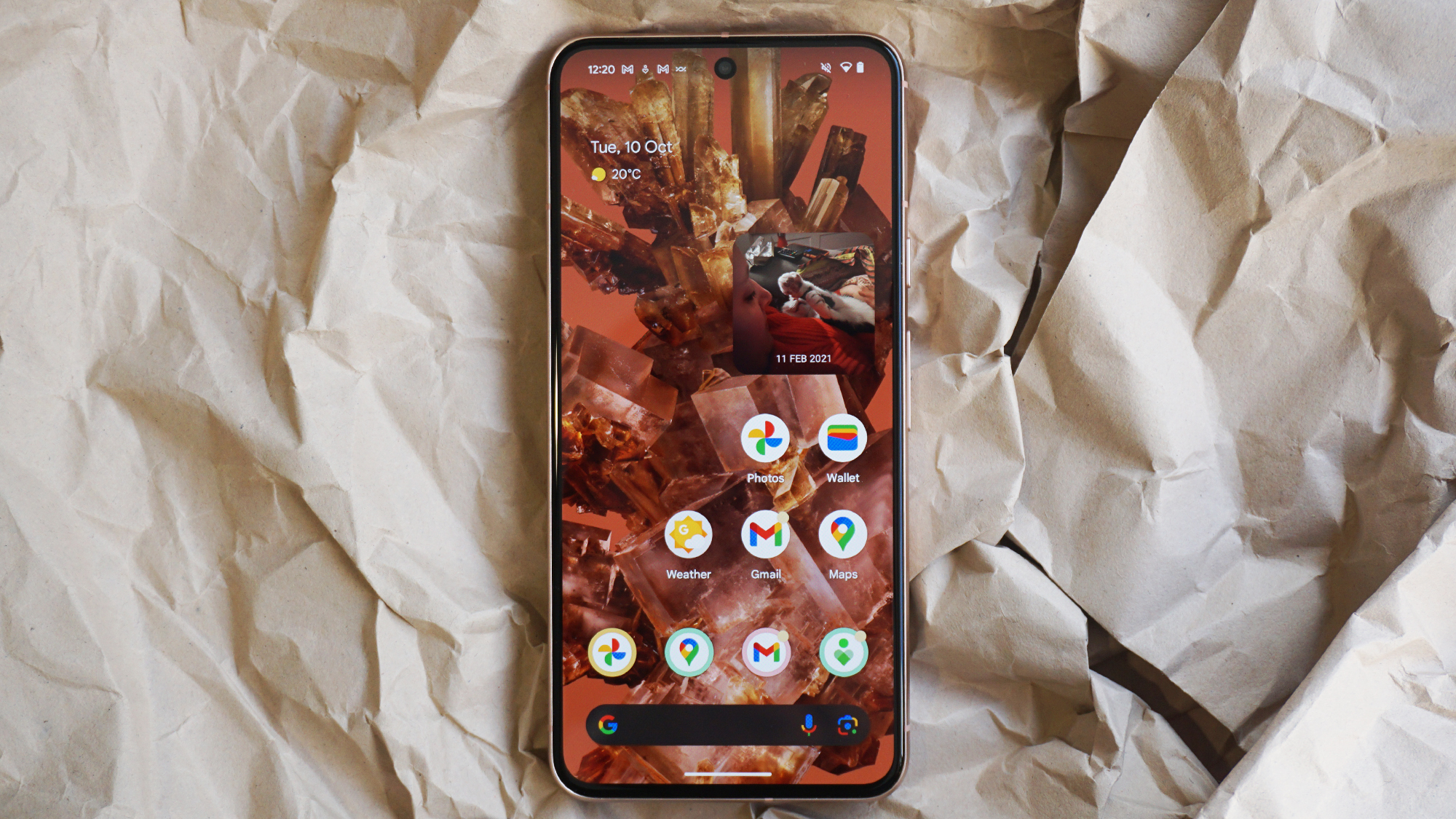
As ever, the promise of Google's Tensor chipset isn't more power, so much as more room for AI-based wizardry, which is most tangible on the Pixel 8 in the camera experience, and the powerful tools integrated into the Photo app. The Pixel 7 took great pics from its main 50MP camera, and there was already a decent level of versatility, but the refinement of the photography experience on the Pixel 8 is evident.
On the hardware side, while that main snapper takes in more light, the 12MP ultra-wide that accompanies it now boasts autofocus, unlocking a macro shooting mode that, last year, was exclusive the Pixel 7 Pro. Paired with Google's top-tier image processing, even when zooming in and despite the lack of a true telephoto lens as found on the 8 Pro, the camera system on offer delivers impressive versatility that most users should be more than happy with.
Google being Google, you also get access to powerful new corrective tools, like Best Take, which helps you collate the right combination of faces from a burst of group shots, as well as Audio Magic Eraser, which as the name implies, leans on the Tensor G3's AI smarts to iron out unwanted background noise against the wanted audio of your video's subject. These are the kinds of features that help set the Pixel experience apart from the rest, and the number of features the standard model possesses isn't anything to be sniffed at.
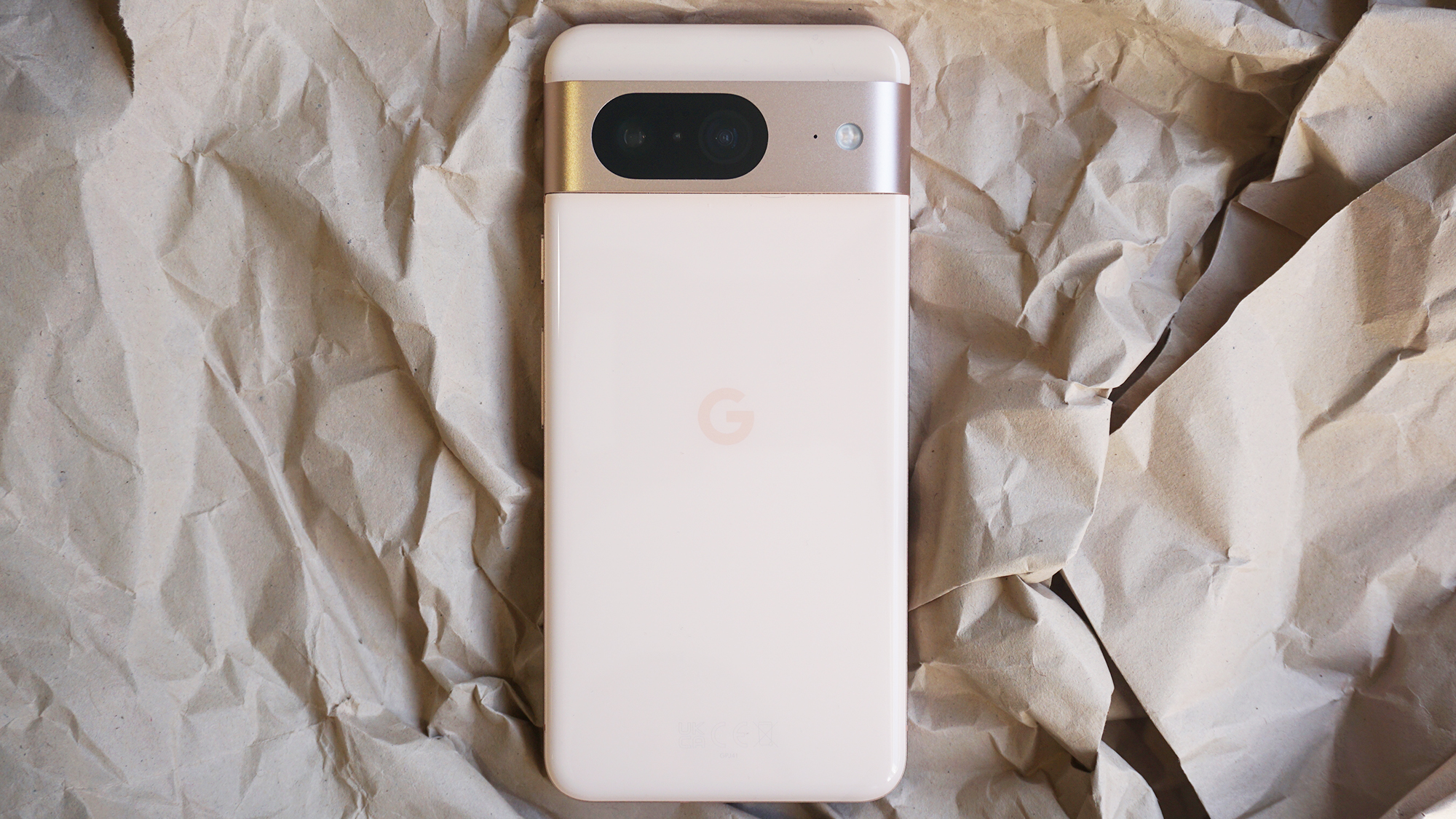
A surprisingly large battery and decent all-day battery life round out an otherwise predictable but capable generational upgrade that's priced to light a match under both Apple's and Samsung's latest baseline flagship phones (check out our iPhone 15 review and Samsung Galaxy S23 review for more context).
So long as you don't prize a telephoto lens, and can live with fewer ultra-wide megapixels, you won't sacrifice too much if you choose the Pixel 8 over the Pixel 8 Pro.
Want more of our thoughts on the latest Pixel products? Check out our Google Pixel 8 Pro review and hands-on Google Pixel Watch 2 review too.
Google Pixel 8 review: Price and availability
- Priced from $699 / £699 / AU$1,199
- On sale from October 12, 2023
- Pricier than its predecessor
Google unveiled the 6.2-inch Pixel 8 and 6.7-inch Pixel 8 Pro at its October 4, 2023, Made by Google event, at which it also launched the new Google Pixel Watch 2.
The Pixel 8 starts at $699 / £699 / $1,199 for the 128GB model, which is similar to what you would have paid last year for the higher-capacity 256GB Pixel 7, marking a generational price increase that, admittedly, is far more noticeable with this year's Pixel 8 Pro. If you do want the top 256GB Pixel 8, that'll cost you $759 / £759 / $1,299, with the added quirk that this variant is only available in Obsidian (black) for those looking to buy the Pixel 8 in Australia (the 128GB version can be had in all three colorways).
Here's a full price breakdown for the Pixel 8:
- Value score: 4 / 5
Google Pixel 8 review: Specs
Google Pixel 8 review: Design
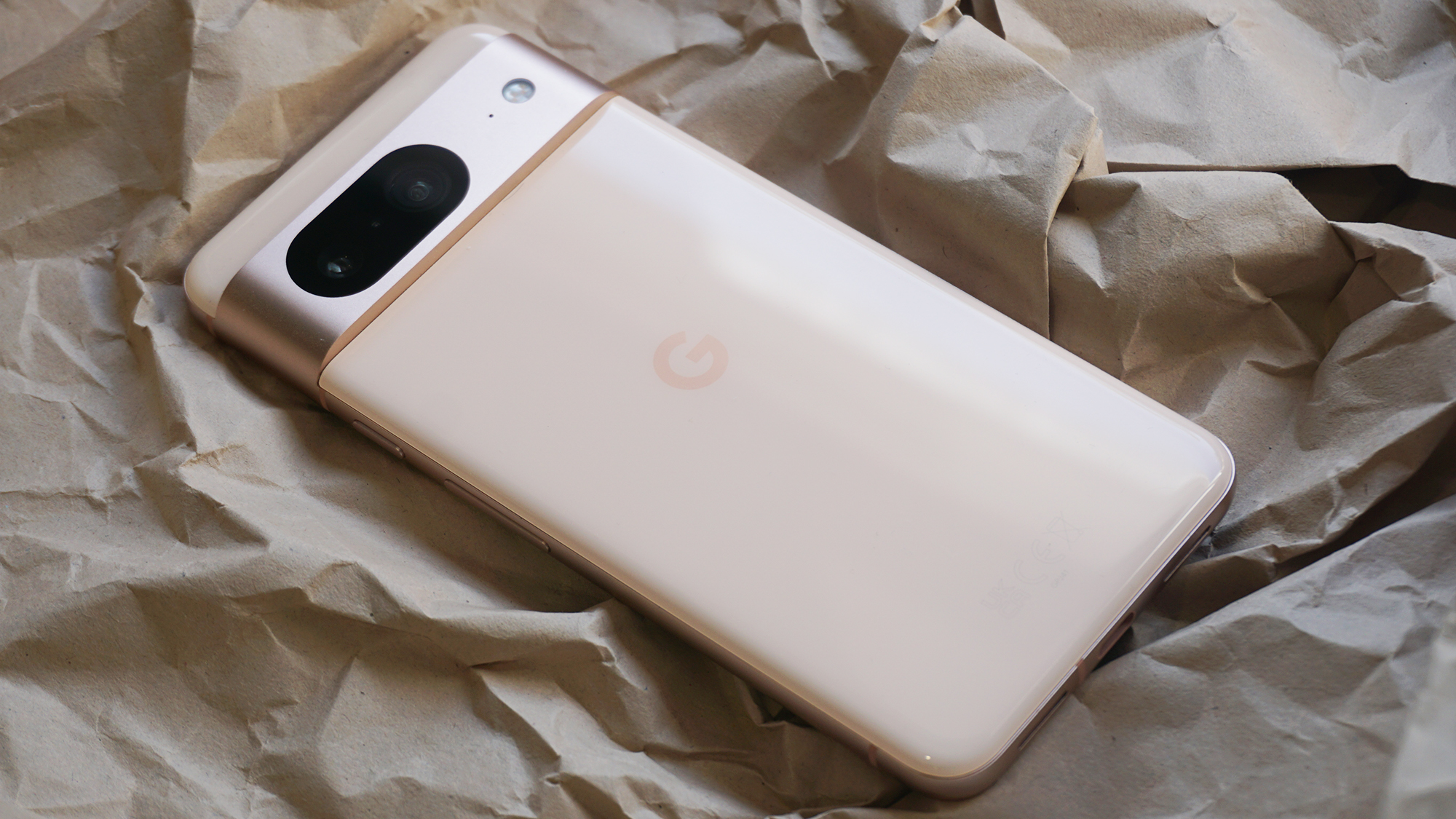
- More rounded corners than predecessors
- Pleasingly compact
- Underwhelming choice of colors
For the Pixel 8, you get a familiar design across both models, with the now-iconic camera bar along the back (matte on the 8 and polished on the 8 Pro), as well as more rounded corners that make the design of both new Pixels softer and more approachable than their forebears.
The more rounded form and adjusted 20:9 aspect ratio combine to make the 8 a nicely compact and pocketable Android phone, and excluding the distinct camera bar (and the added thickness it brings), the 8's silhouette is very similar to that of a key rival when it launched, the Samsung Galaxy S23.
No only is there a greater generational disparity in screen sizes with the Pixel 8 line, the Pixel 8 sheds a noticeable amount of weight compared to its predecessor, dropping from 197g down to 187g, as well as being a little less tall and a touch narrower.
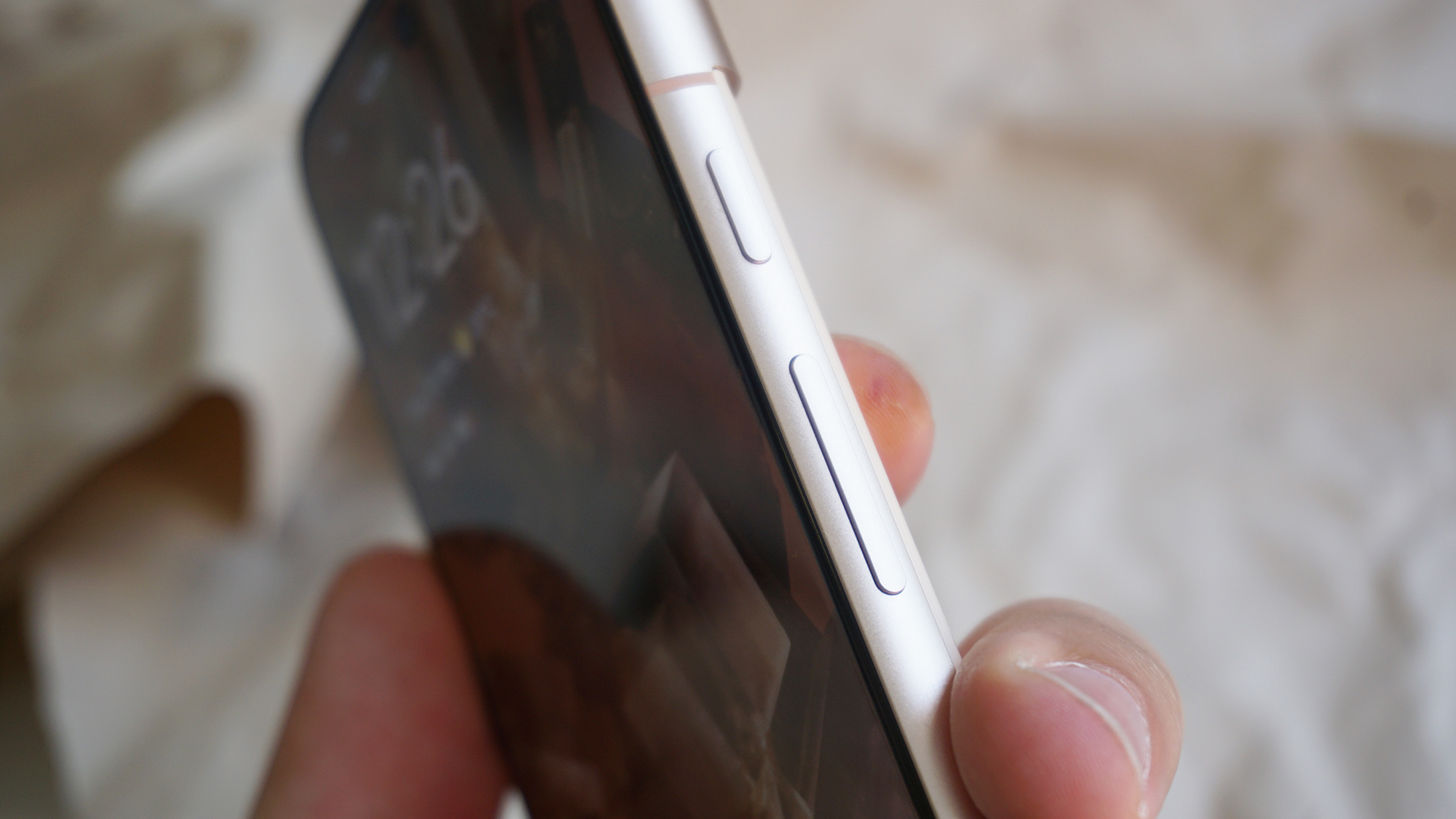

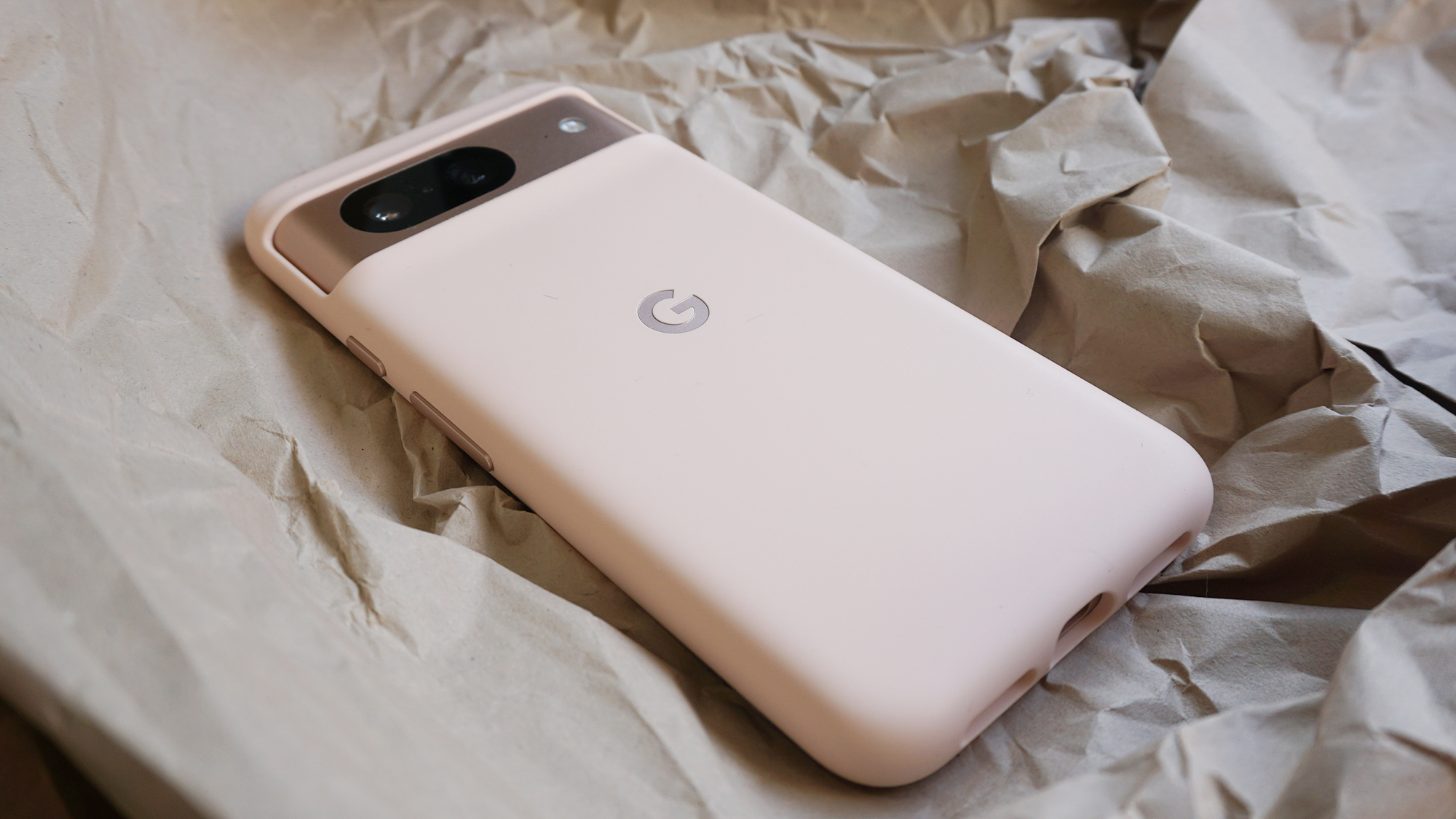

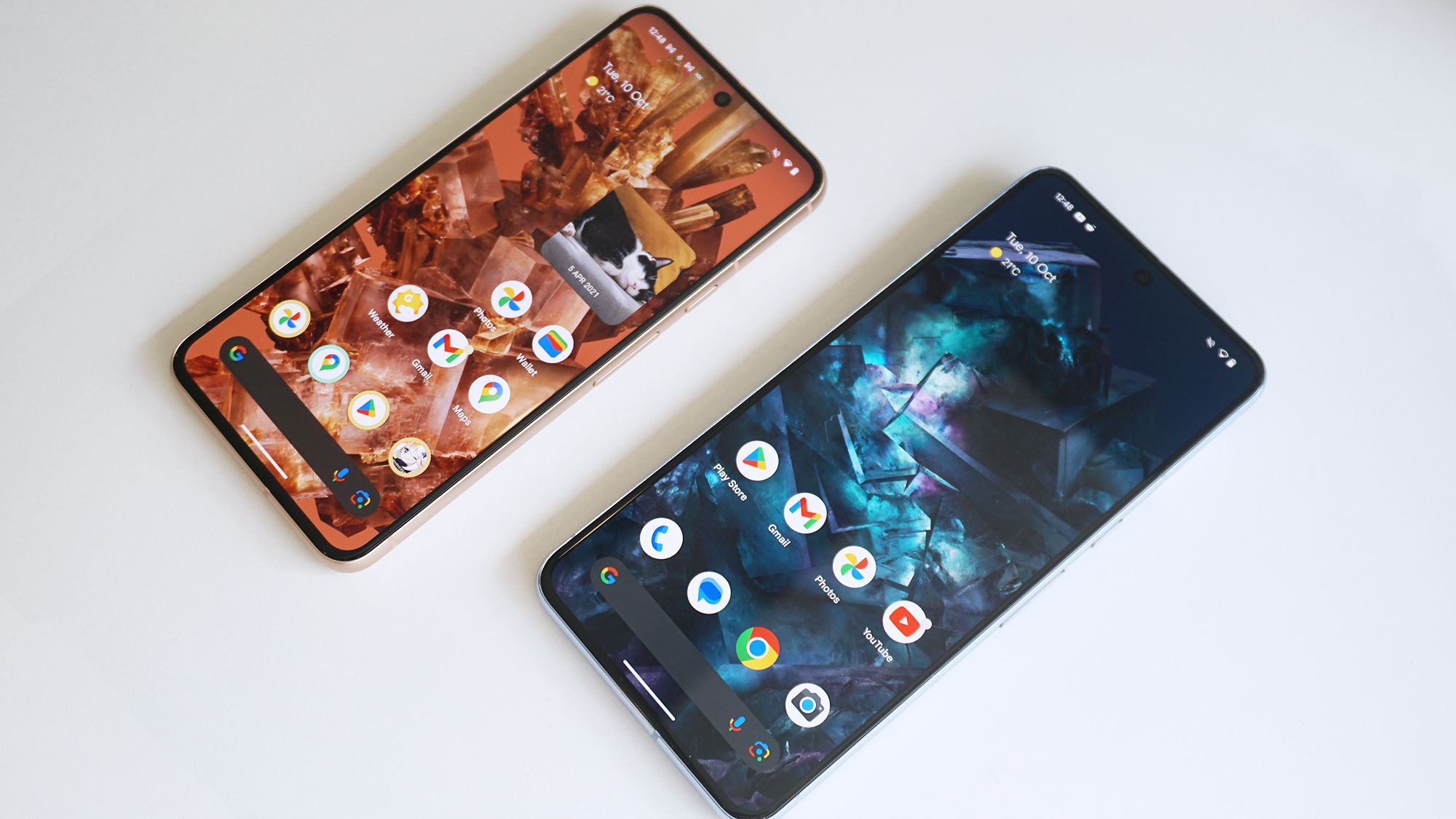




It feels great in the hand, even if it has gotten just a tiny bit thicker, and if you stick on the official case it looks downright adorable, akin to a small pillow. Even with the softer lines, the placement and feel of the hardware controls along the right side is comfortable and within easy reach, the in-display fingerprint sensor proves consistent (maybe a little faster would be nice, Google), and the camera bar creates a nice groove on which to rest the tip of your finger to keep the phone from slipping, despite its shiny glass back.
Thanks to the reduction in size, one-handed use is that much more approachable for most users, and the tight tolerances at work accommodate IP68-certification against dust and water.
Not everyone loves the current Pixel's camera bar-led aesthetic, but even for those who don't, the hardware within, and the practical ergonomics of its presence, make it more worth having than not.
I just wish Google had gotten a little more creative with the colorways for the Pixel 8. We handled the Hazel version during our hands-on, which – as on last year's Pixel 7 Pro – is more of a putty green/gray, while Rose (pictured here) falls into the same trap as Samsung's Galaxy Z Flip 5 foldable: a pretty pastel that needs just a hair more saturation to be interesting.
- Design score: 4 / 5
Google Pixel 8 review: Display
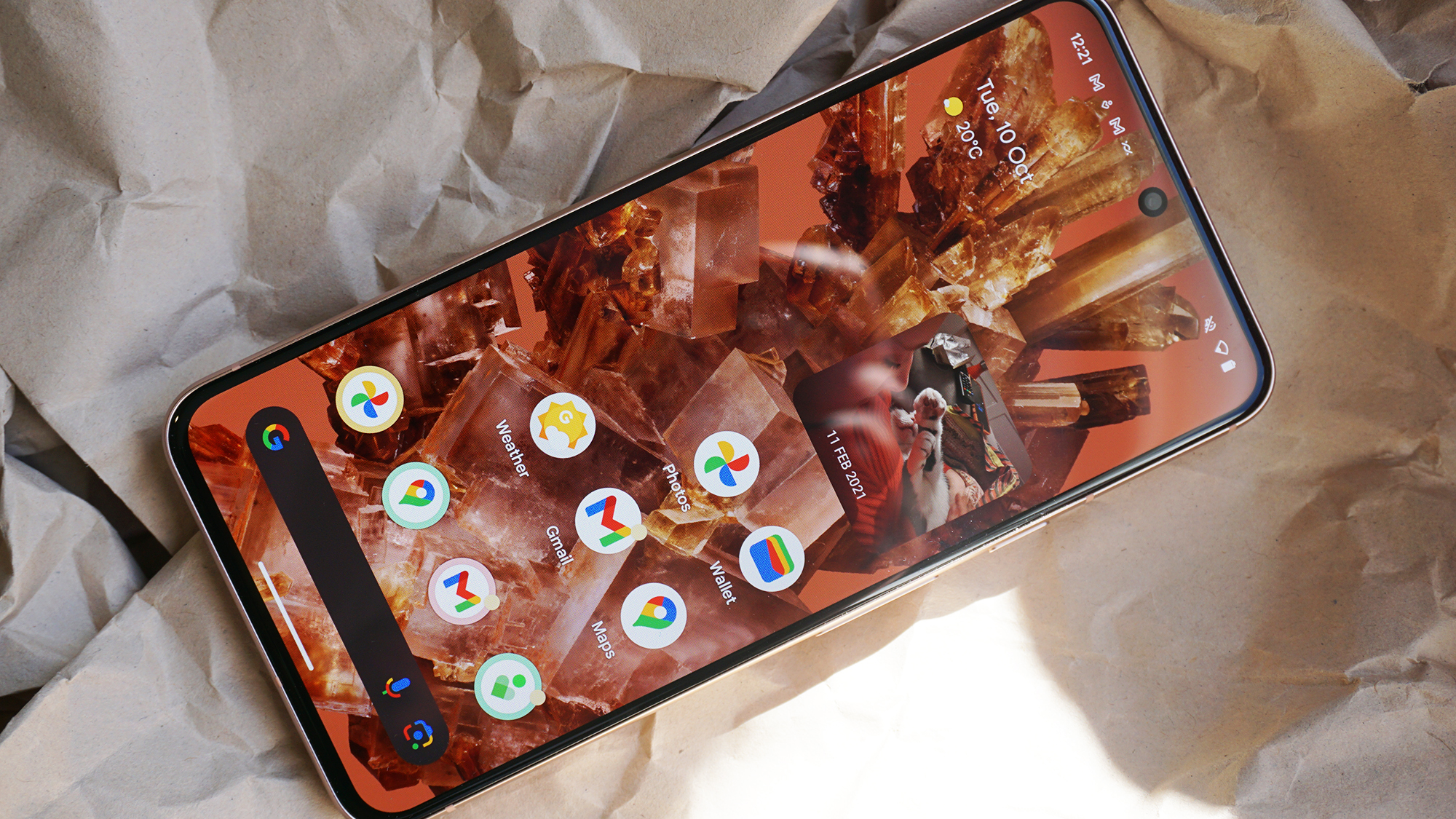
- Newly-branded 6.2-inch 'Actua' OLED display
- Finally supports 120Hz refresh rate
- Improved brightness up to 2,000-nit peak
Google may have shrunk the screen just a tiny bit compared to the Pixel 7, but it's maintained the resolution, while updating the peak brightness to 2,000 nits and increasing the max refresh rate to 120Hz – all welcome improvements.
We've been stuck on 90Hz since the Pixel 4, and while the 120Hz isn't essential, it's a nice addition that helps narrow the gap between the Pixel 8 and its most prominent rivals, notably the Galaxy S23. The caveat is that, unlike the Pixel 8 Pro's adaptive LTPO OLED, 120Hz viewing on the standard Pixel 8 is binary; you can turn it either on or off by flipping the 'smooth display' toggle in the settings menu ('off' takes things back down to a baseline 60Hz). As such, you have the option to always enjoy more fluidity across the user experience, but at the expense of extra battery drain, and unlike adaptive refresh rates, it's up to you to more actively manage power consumption with this feature, which is a little irritating.
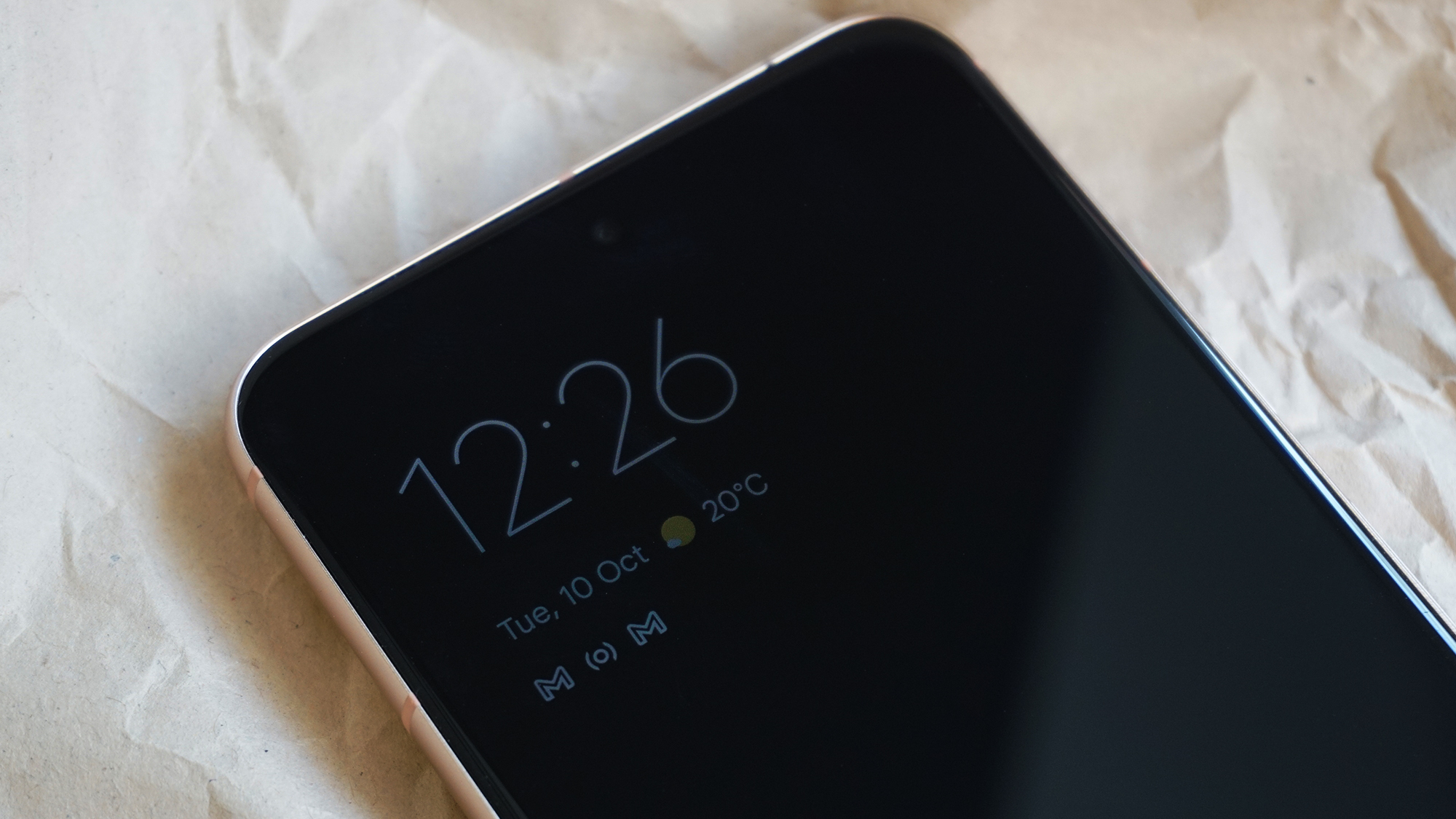
There's a minimalist and functional always-on display on offer, which is useful for keeping tabs on the time and notifications at a glance, while Night Light is on hand to warm the color temperature of the display in the evenings, or make low-light viewing easier on the eyes in dim environments.
The drop to 6.2 inches without a change in resolution between generations means the Pixel 8 is technically a hair sharper than the Pixel 7 (not that you'd likely tell with the naked eye), while colors, contrast and viewing angles are all top quality for a phone at this price. That peak brightness bump is welcome too, keeping step with similarly improved competitors like the iPhone 15, and ensuring that outdoor visibility is good.
- Display score: 4 / 5
Google Pixel 8 review: Software

- Android 14 out of the box
- Generally small tweaks from Android 13
- Impressive 7 years of OS, Pixel Feature Drop and security updates
Android 14 debuts on the Pixel 8 series, and while the majority of the numerous tweaks are small, one of the most tangible upgrades is a new customizable lock screen that lets you change the clock style and shortcuts available in the bottom corners. This is one of the those changes where Google is playing catch-up to other Android phone makers, but the addition is welcome nonetheless.
Android 14 also bring reworked animations (like a new charging indicator when you plug the phone in) and additional control over things like hotspot speed and compatibility, while the clock in the notifications shade is now a shortcut back to the clock app, and ring and notifications volume sliders have been separated. None of these are improvements to get particularly excited about, but their inclusion is appreciated.
Google's take on Android, as it appears on the Pixel 8, is clean and inoffensive, with a light amount of personalization to help build a coherence into the user experience across its devices. There are other tweaks that I've seen on non-Pixels that I would have liked to have seen here – among them the ability to monitor and deny who has an active connection to my device's hotspot – but for the most part the Pixel serves up an easy-to-use, tastefully styled and well-featured user experience.
Where the Pixel 8 really stands apart from almost every other phone on the market is its new software promise. Unlike its predecessors, which in recent years have come with three years of OS updates and five years of security updates post-launch, this year's Pixels come with the promise of seven years of OS, Pixel Feature Drop and security updates, a truly impressive commitment that undermines one of the iPhone's biggest selling points, and dramatically improves the value-for-money proposition for Google new phones.
- Software score: 5 / 5
Google Pixel 8 review: Cameras

- 50MP f/1.68 main + 12MP f/2.2 ultra-wide rear cameras
- Ultra-wide camera now supports autofocus in macro mode
- 10.5MP front-facing punch-hole camera
- New features include Magic Editor and Best Take
Google is blurring the lines between photography and photo manipulation on the Pixel 8
There's a more prominent disparity between the camera setups on the Pixel 8 and the 8 Pro, relative to their respective predecessors. The obvious lack of a dedicated telephoto sensor means the Pixel 8 tops out at an 8x Super Res Zoom (read: digitally enhanced zoom), while the 8 Pro has 5x optical zoom, with Super Res Zoom up to 30x. The 8 Pro uses a new 48MP ultra-wide camera too, while ultra-wide on the standard 8 packs a 12MP sensor, like its predecessor. The front-facing 10.5MP camera on the Pro boasts autofocus, against the fixed-focus sensor on the 8.
While these might seem like major shortcomings for the standard Pixel 8's photographic experience, in practice it's still an excellent camera phone in its own right. The main 50MP sensor has a wider aperture than that of its predecessors, meaning more light and thus better-quality shots in more challenging conditions. The ultra-wide, meanwhile, now offers autofocus, unlocking the macro shooting mode that was last found on the Pixel 7 Pro.
A reworked camera UI makes it easier to jump between the phone's various still and video capture modes, and with the backing of that new Tensor G3 chipset and impressive new AI capabilities, Google is blurring the lines between photography and photo manipulation on the Pixel 8, something that's best demonstrated by the new Magic Editor.
So long as you're happy to upload your photos to the cloud, Magic Editor is an evolution of Google's Magic Eraser tool. It lets you tap and drag on subject in a photo to move it, with the AI processing intelligently filling in the space where the subject was. Moreover, I was able to replace the blue sky of the original image with a wholly fake golden-hour sky (see above), one of a handful of suggested sky variations that Magic Editor generated; you can simply tap to generate more alternatives, presumably infinitely.
In a similar fashion, Best Take can take a series of photos of a group of people shot in succession and, with your guidance, find the best expression for each person across all the photos, and then create one photo in which everyone is looking at the camera and smiling. It's wild to see this working before your eyes, if perhaps a little unsettling.
Google Pixel 8 camera samples


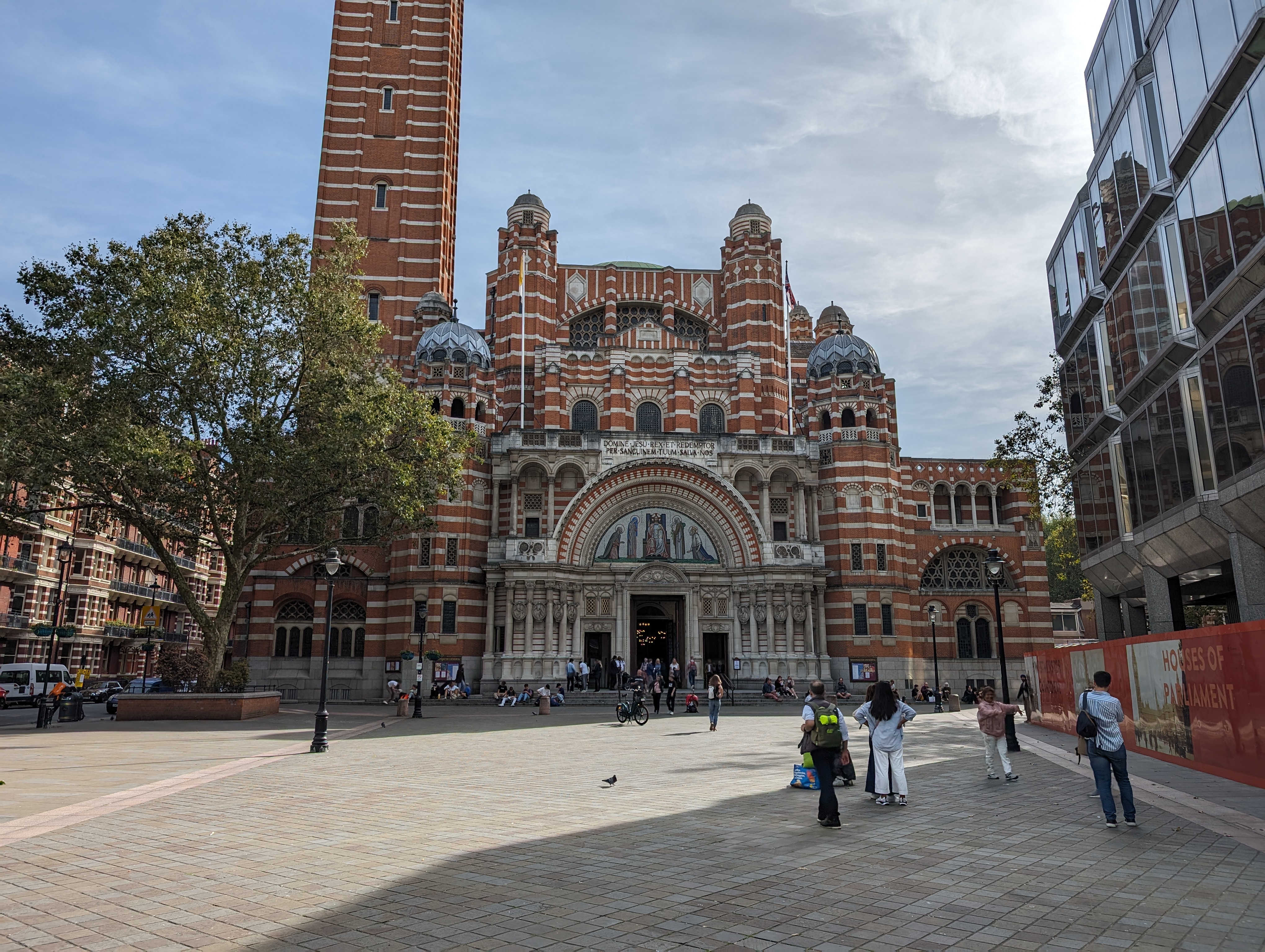






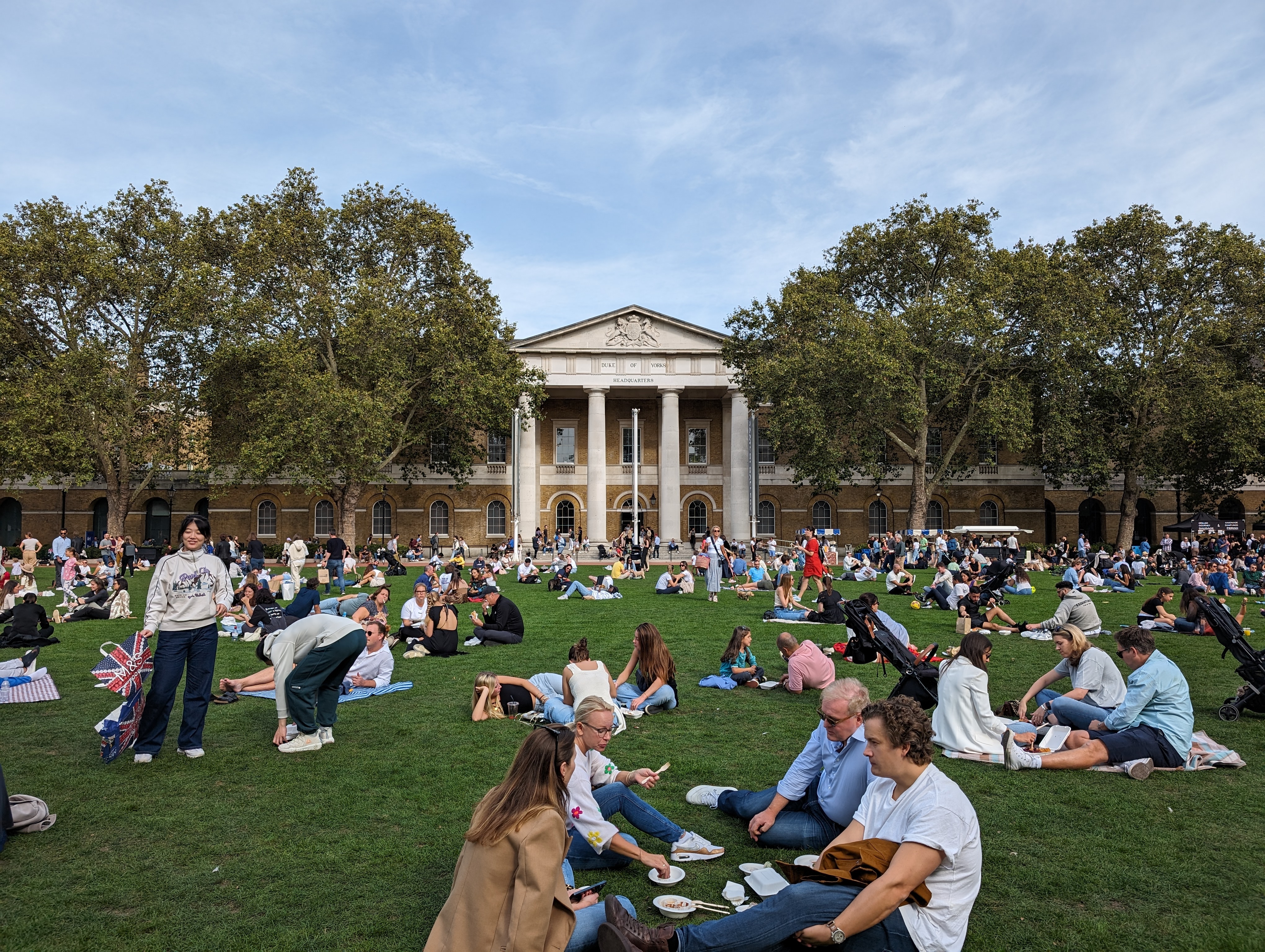
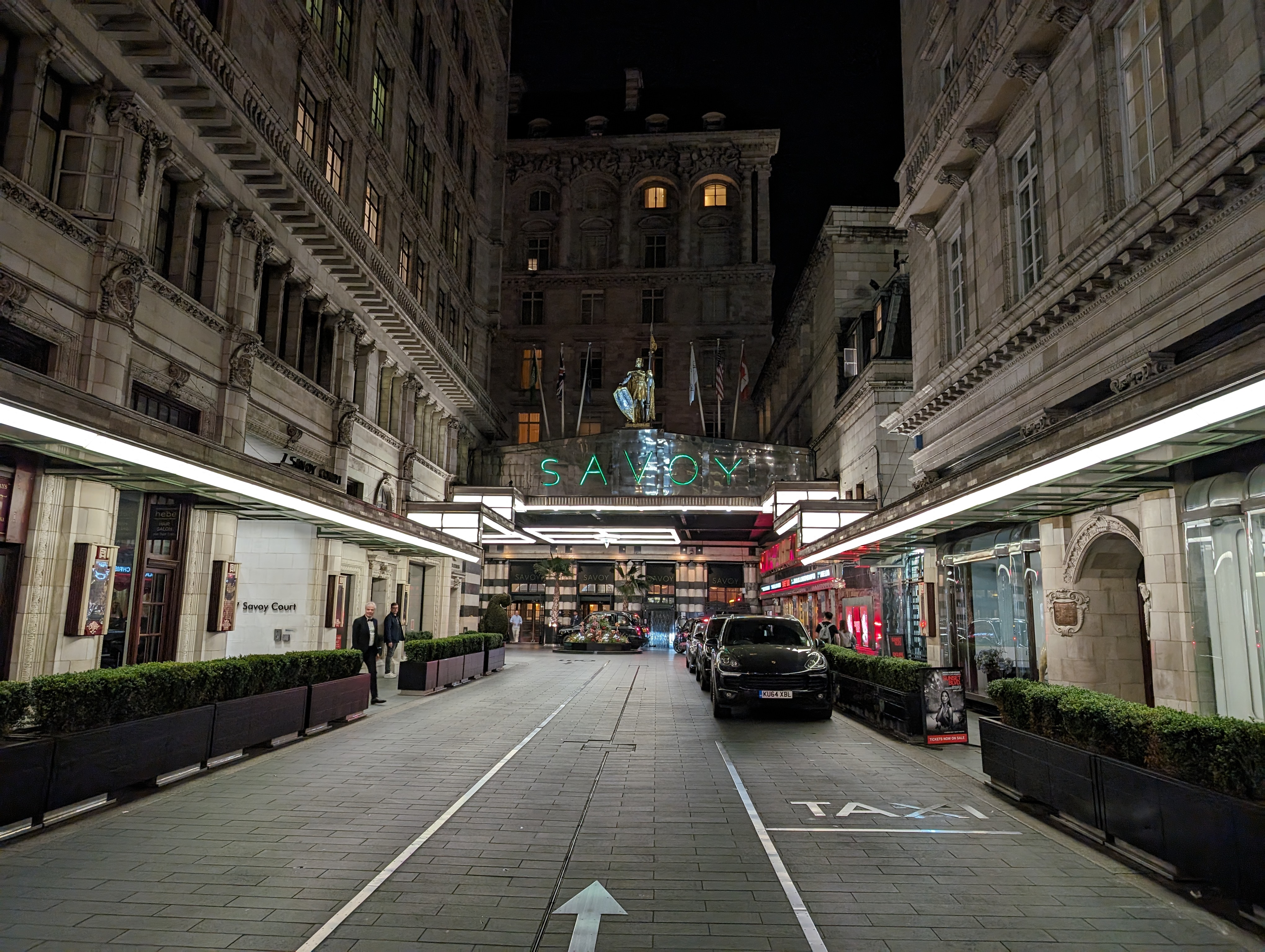




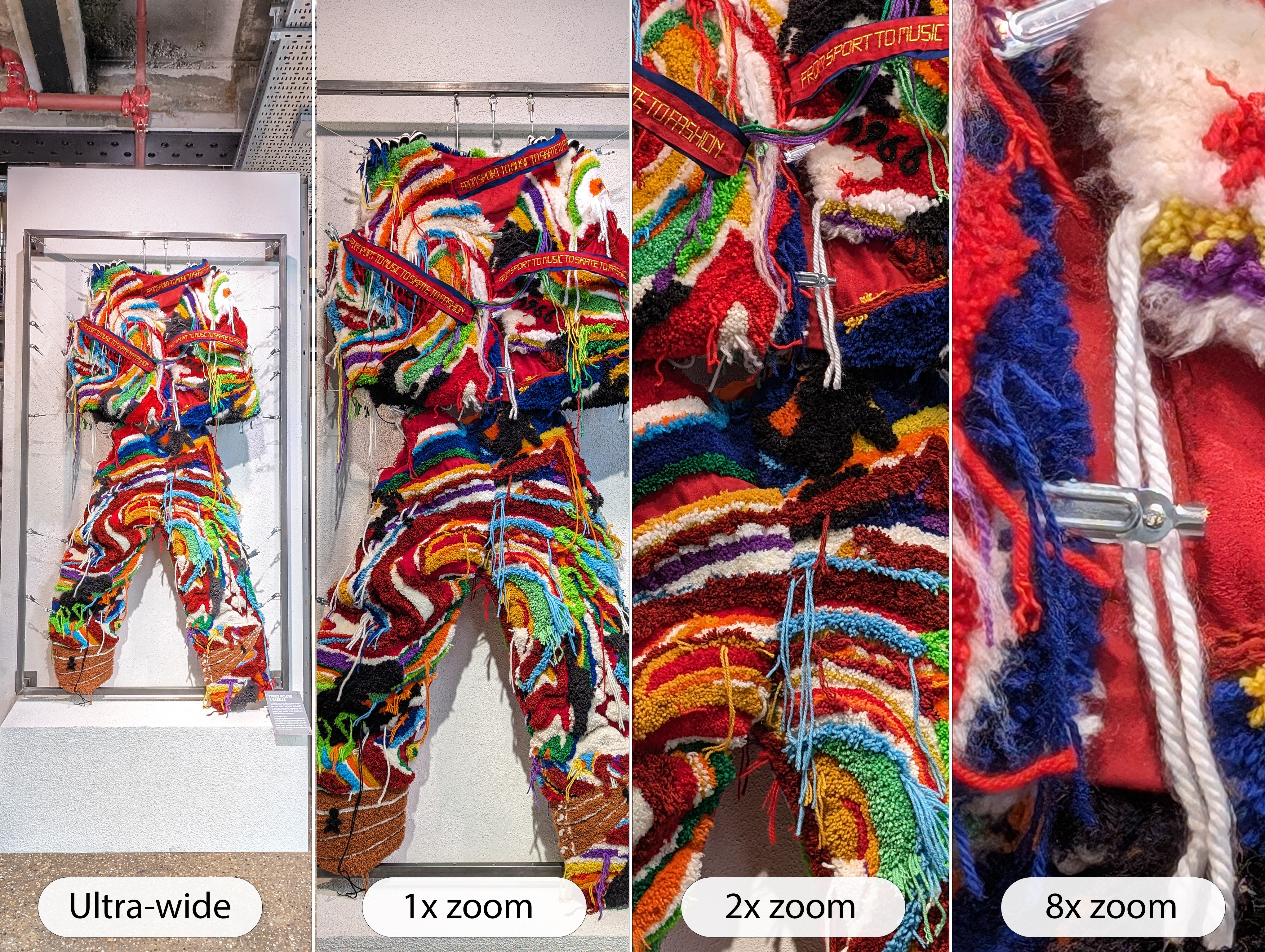
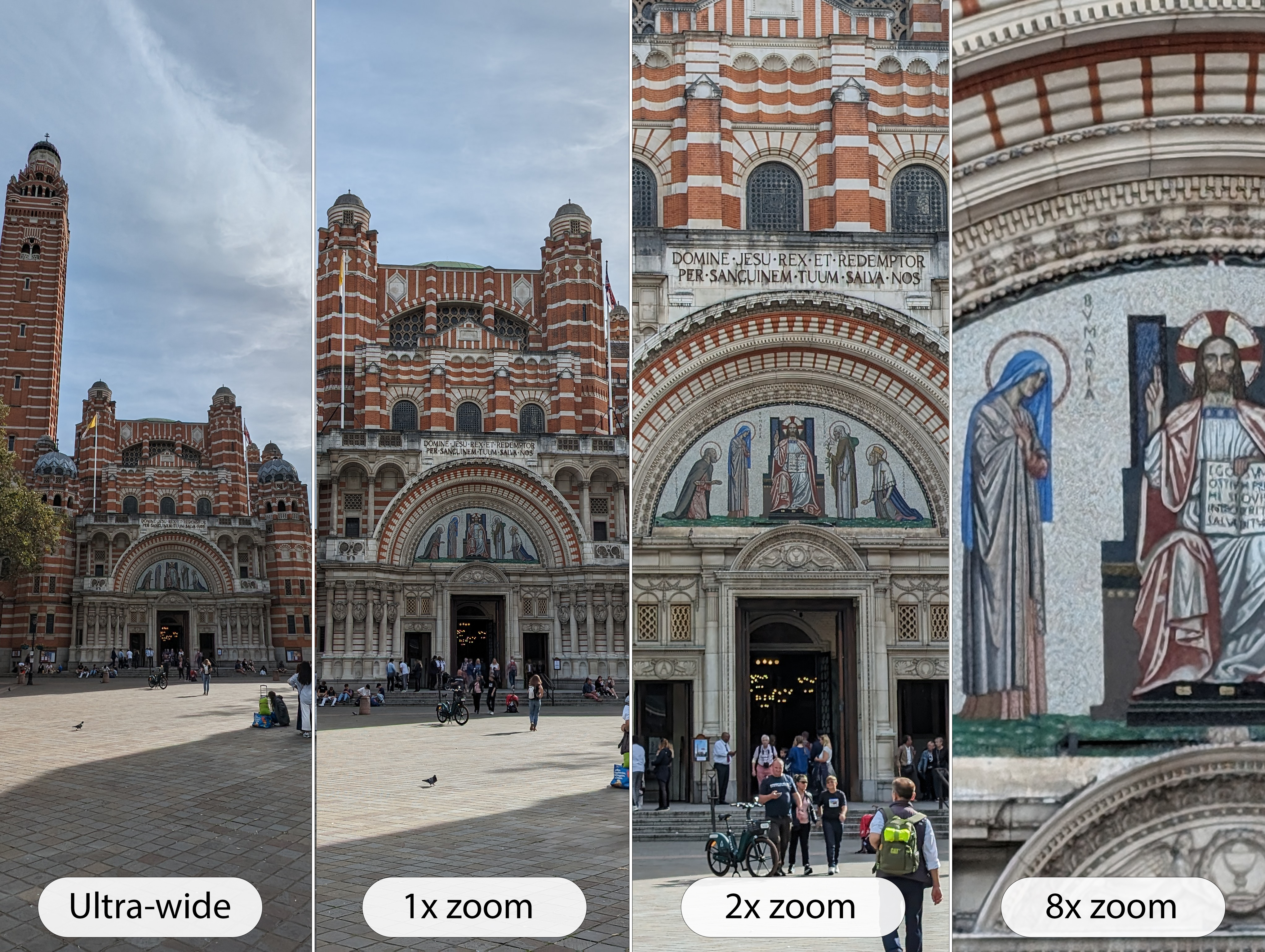
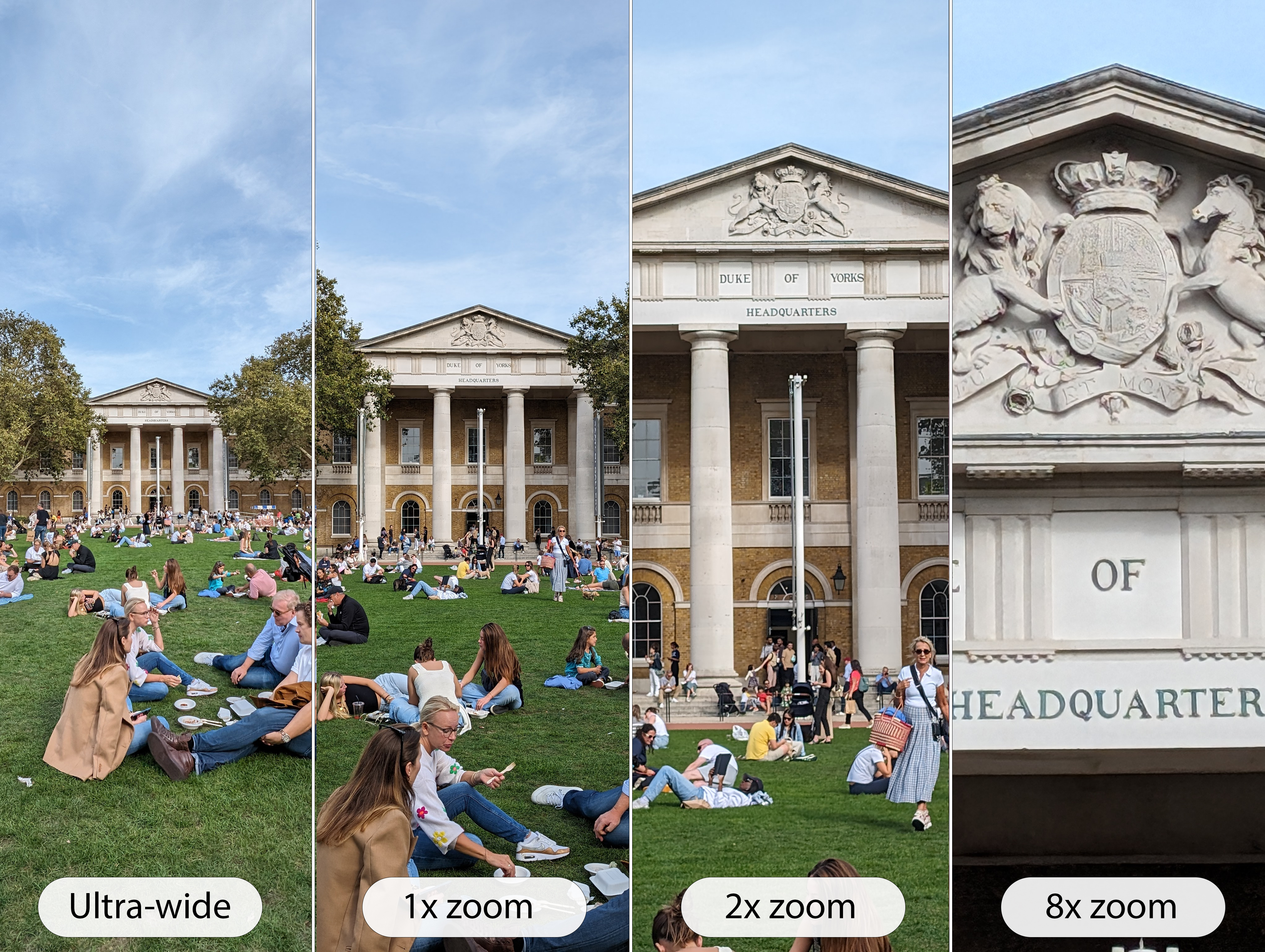

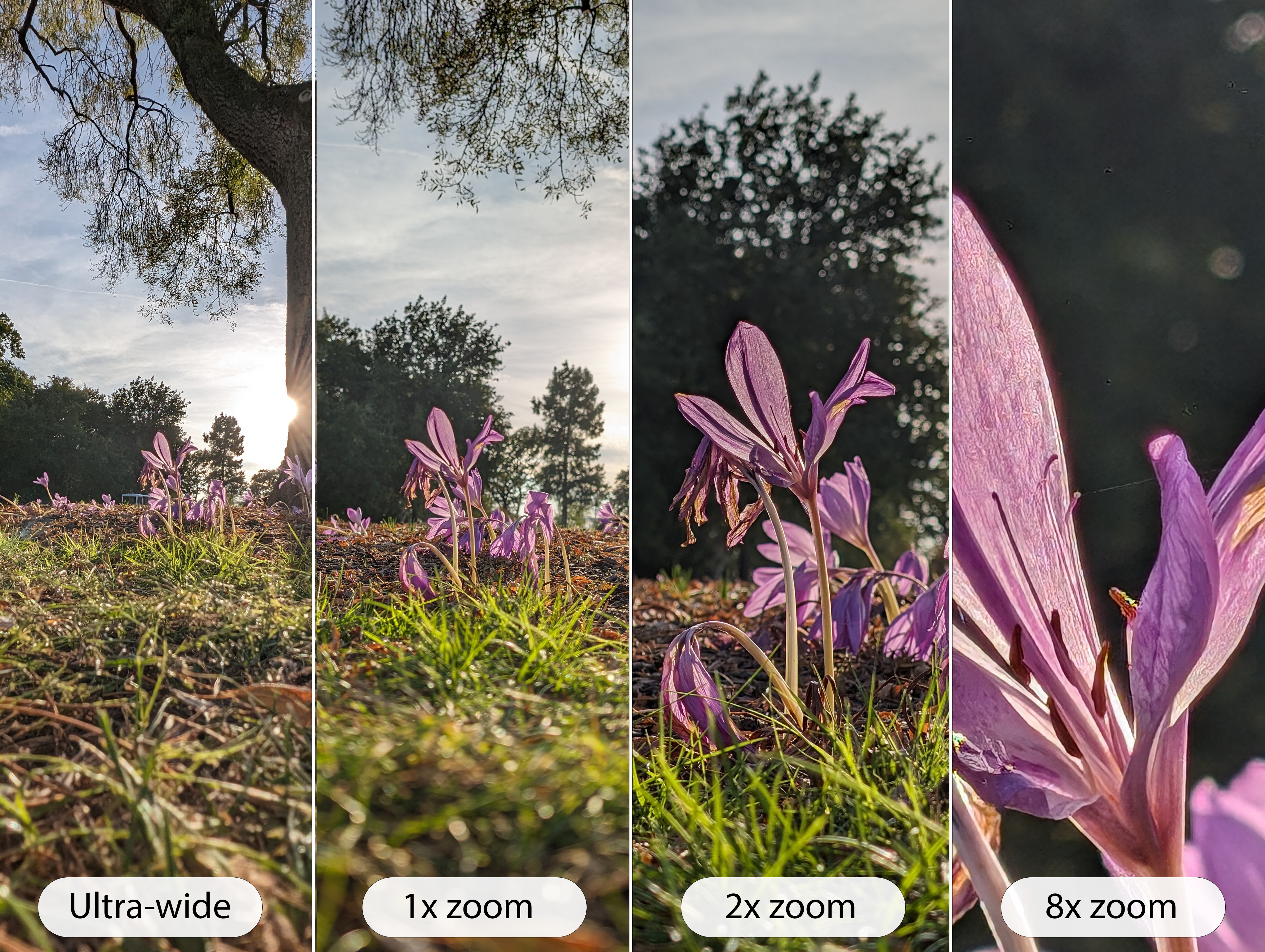
As for the actual shooting experience on the Pixel 8, its predecessor's main camera was already excellent, and that's the case here too. Google's image processing brings photos to life, even before you lean on any additional AI enhancement. Low-light shooting offers better color accuracy and exposure, presumably thanks to that wider aperture, while edge detection around elements like hair in portrait mode shots is impressive too.
Consistency with regards to color, dynamic range and contrast between the main and ultra-wide sensors is closer than expected, even in low light, making this a more dependable set of cameras than on the likes of Samsung's Galaxy S23 handsets. The peak 8x Super Res Zoom seriously impressed too, retaining far more detail than expected, and producing some great shots that almost made me forget about the Pro's 5x telephoto... almost.
While I'm disappointed that the Video Boost feature, which lets you shoot at up to 4K 60fps, with Google processing every frame through its HDR pipeline for better colors, dynamic range and low-light performance, looks set to remain a Pro-only offering for the time being, the Pixel 8 does get the company's new Audio Magic Eraser to help you remove distracting noises from your videos.
In practice, it does a decent job, with resultant audio that sounds like active noise cancellation is running, even though it was applied after the fact. Out of the box, the feature has tailored suppression for speech, noise or nature, and I hope Google improves the quality of these before it looks to add more use cases.
- Camera score: 4.5 / 5
Google Pixel 8 review: Performance

- Google Tensor G3 SoC
- Dedicated Titan M2 security coprocessor
- Maximum of 256GB storage
Rather than competing directly with the iPhone's A-series chips or Qualcomm's current Snapdragon 8 series flagship silicon for raw power, the new Tensor G3 chipset in the Pixel 8 promises more of what Google's mobile silicon is known for – AI-powered functionality.
From the powerful photo-editing tools already discussed to features like Live Caption (which transcribes spoken word to on-screen text in phone calls), voice typing, and even Guided Frame (which helps visually impaired users take photos through spoken prompts), a whole host of the Pixel 8's feature set relies on the AI-related abilities of the Tensor chip.
While AI prowess is hard to quantify (especially as Google disabled benchmarking apps during the Pixel 8's review period), the company did explicitly state at launch that the Tensor G3 can run twice as many machine learning models compared to the Tensor G1, which debuted in the Pixel 6 series, and that "the heaviest model on Pixel 8 is ten times more complex, compared to Pixel 6."
As part of a future planned Feature Drop, Google is looking to expand the G3's onboard large language model (LLM), which should result in the Google Assistant being able to summarize web pages (like a recipe), or read aloud from a variety of text sources, even translating to other languages, on the fly.
Google’s Call Screening also gets an update, with a much more natural-sounding voice. In a demonstration during our hands-on with the phone, a Google rep, acting as a delivery person, called a Pixel 8 Pro that was set to screen calls. The Pixel 8 Pro answered, and the rep explained that they had a package to deliver.
On the Pixel 8 Pro, we were able to type a note telling the delivery person they could leave the package by the door, and the Pixel 8 Pro relayed that message in its normal-sounding voice. If the voice hadn’t identified itself as a personal assistant, we would never have known it was an AI. The caveat is that these advanced AI features appear to remain US exclusive, for the time being.
The Tensor G3 also boasts an upgraded GPU, which in practice holds up well for mobile gaming. The Pixel 8 was more than comfortable with Genshin Impact at 'medium' settings, set to 60fps, felt warm after a few minutes of play on 'high' settings (again with fps set to 60), and only started to drop the occasional frame with settings set to highest and fps dialed up to 60). Ultimately, the Pixel 8's performance here should satisfy all but the most serious gamers.
- Performance score: 4 / 5
Google Pixel 8 review: Battery
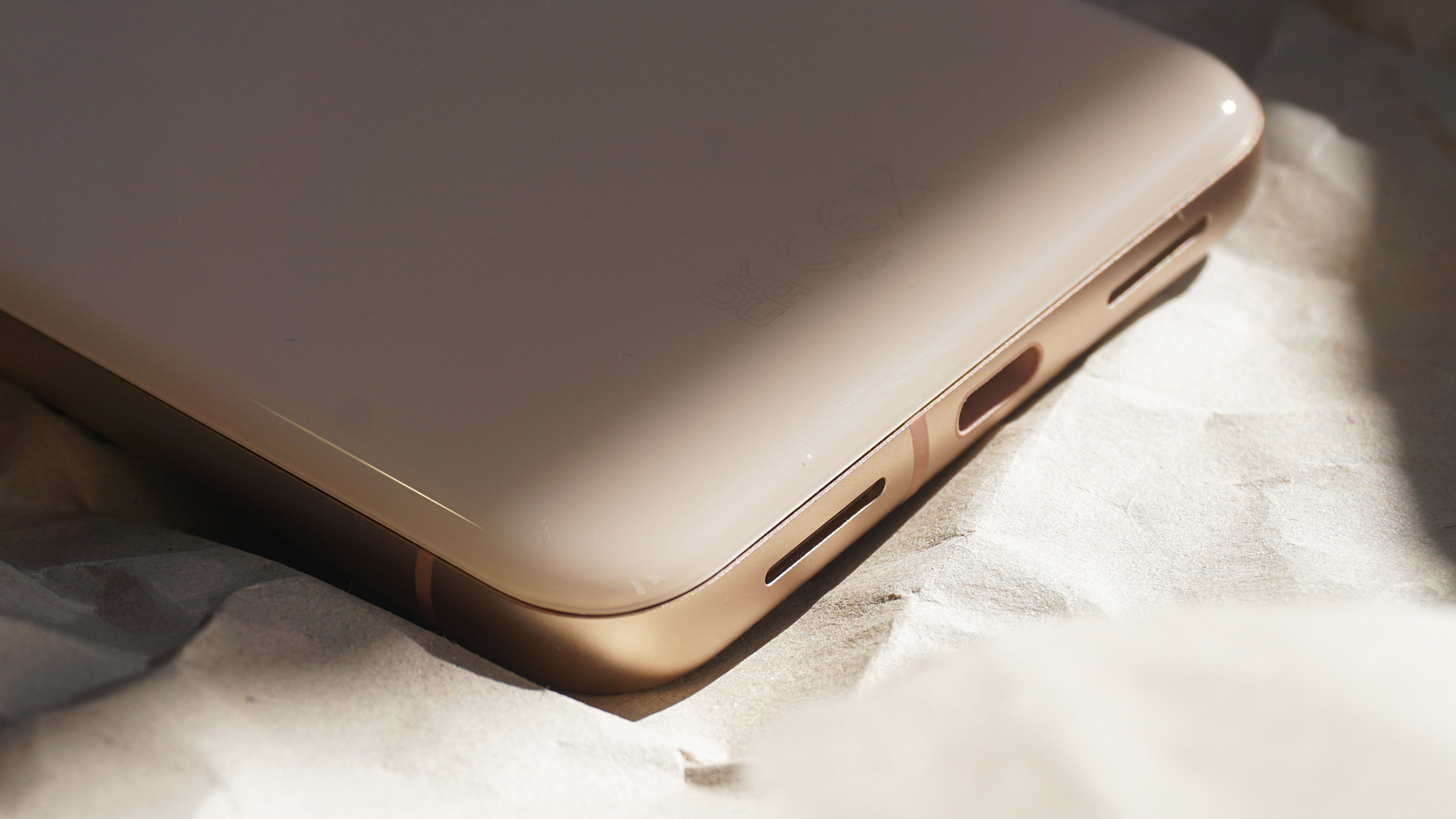
- Larger battery than Pixel 7, smaller then Pixel 6
- Just over six hours screen-on time
- 27W wired, up to 18W wireless charging
The Google Pixel 8's 4,585mAh battery is fairly large, considering the phone's diminutive size, falling in between the Pixel 6's and Pixel 7's, in terms of capacity.
It's roughly on a par with the Pixel 7 for all-day use (it's a little better), with approximately six hours of screen-on time from a single charge, meaning you've got enough leeway to use heavy apps throughout the day without having to tread too carefully. Gaming is, unsurprisingly, one of the most demanding things you can do on a phone, and 30 minutes of graphically intensive title like Genshin Impact (medium graphics, 60fps, auto brightness) equated to just over 38% battery drain.
As for charging, Google has upped charging speeds over the last generation, from 21W to 27W wired, with support for wireless charging at up to 18W wireless (when using the second-generation Pixel Stand) or 12W when using a Qi wireless charger. Paired with Google's separately-sold 30W USB-C charger, the Pixel 8 reached 54% in 30 minutes from flat, and fully charged in one hour 23 minutes.
- Battery score: 4 / 5
Should you buy the Google Pixel 8?
Buy it if...
Don't buy it if...
Google Pixel 8 review: Also consider
Even though it's a great device, there's room for improvement on the Pixel 8, not to mention Google has a very specific way of crafting phones that might not be to your taste. If you're also looking elsewhere, one of these phones might be a more suitable alternative.
How I tested the Google Pixel 8
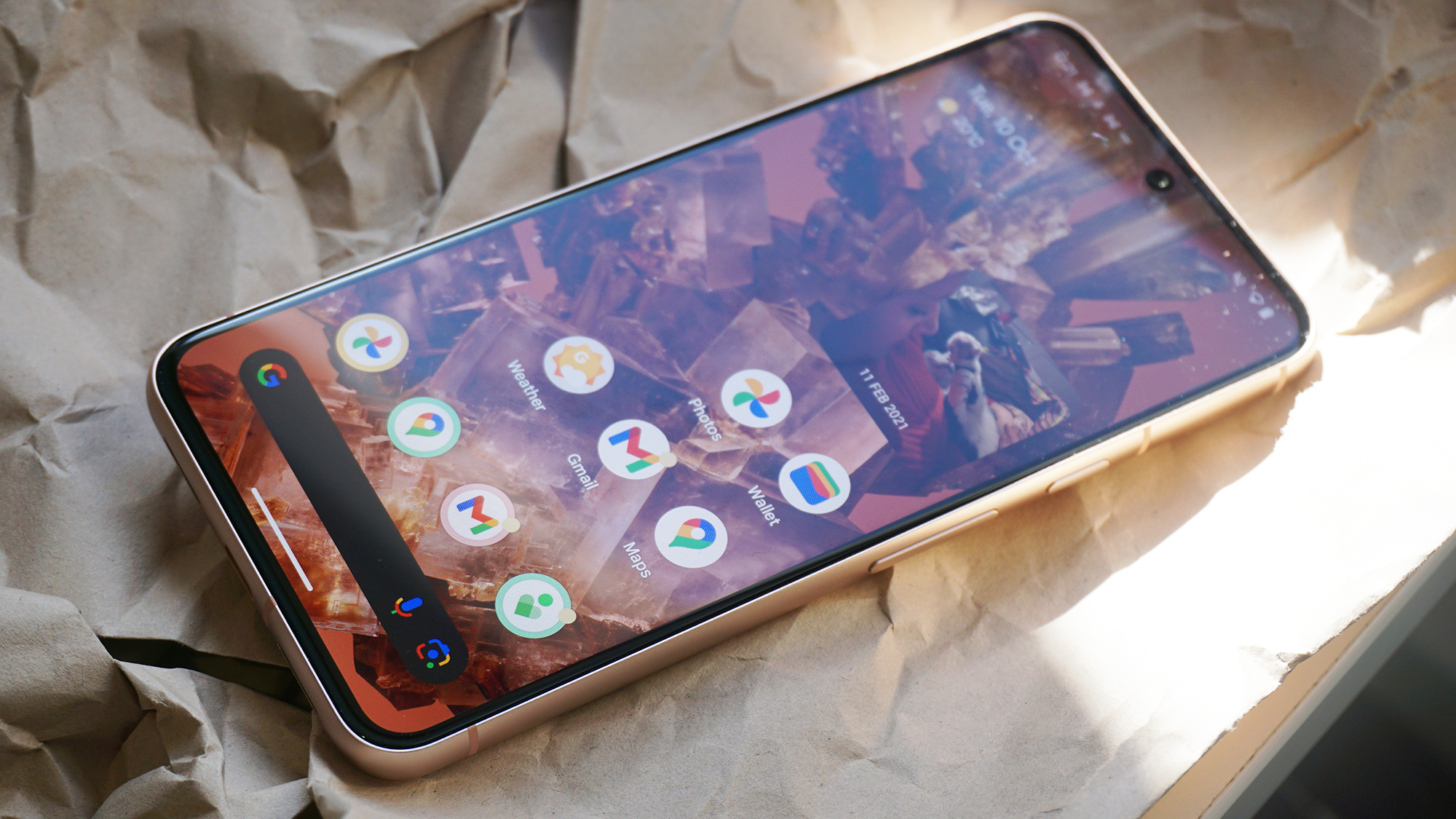
- Review test period: one week
- Testing included: everyday use including web browsing, social media, photography, video calling, gaming, streaming video, music playback
- Tools used: Native Android stats, Google Pixel 30W USB-C charger
I received my Pixel 8 (and 8 Pro) review unit just ahead of launch day, and I was able to put the phone through its paces from announcement, using it as my main device, gaming on it, watching videos on my commute, and snapping photos on my weekend in and around London; it's been a great companion.
I did steal back the official 30W USB-C Pixel charger I bought for my wife a couple of weeks ago, as that's the same charger Google specifies when quoting charging times for its phones, and as a result the company's promise of 50% charge within 30 minutes was unquestionably within reach.
Frustratingly, Google tends to block popular benchmarking apps during each Pixel's review period ahead of going on sale, meaning I was unable to run the usual gamut of compute, AI and graphical benchmarks we run on all phones that come in for review. These benchmarks are far from the be-all-and-end-all of what makes a good chipset, but they do help us to quantify the performance we see in regular use, battery drain, and gaming. I'll likely add benchmarking scores to this review once I'm able to run them on the Pixel 8, but in the meantime, performance was based solely on my real-world experiences, and any data insights I was able to pull from the phone's settings menu. Note: any benchmarking results won't affect section scores or the overall score of this review.
As a reviewer with 12 years experience, and having reviewed numerous Pixels, not to mention and mainlining a Pixel 7 Pro since its launch in late 2022, I felt confident assessing and scoring the Google Pixel 8, both relative to other Pixels, and in the context of the wider smartphone market in which it competes.
First reviewed October 2023







